airbag TOYOTA PRIUS PLUG-IN 2013 Owners Manual
[x] Cancel search | Manufacturer: TOYOTA, Model Year: 2013, Model line: PRIUS PLUG-IN, Model: TOYOTA PRIUS PLUG-IN 2013Pages: 704, PDF Size: 19.59 MB
Page 39 of 704
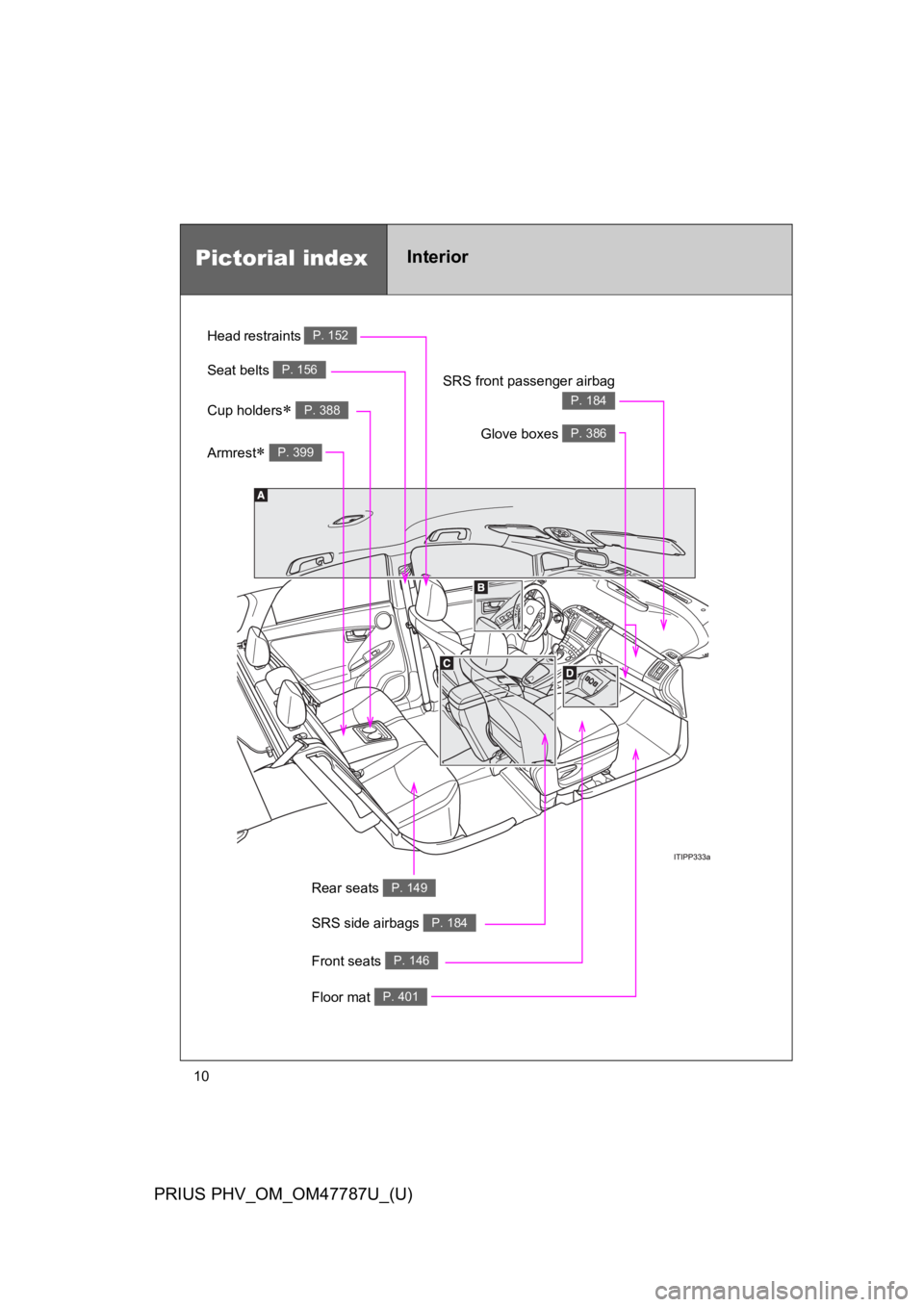
10
PRIUS PHV_OM_OM47787U_(U)
Floor mat P. 401
Pictorial indexInterior
SRS side airbags P. 184
SRS front passenger airbag
P. 184
Front seats P. 146
Rear seats P. 149
Glove boxes P. 386
Head restraints P. 152
Seat belts P. 156
Armrest∗ P. 399
Cup holders∗ P. 388
Page 40 of 704
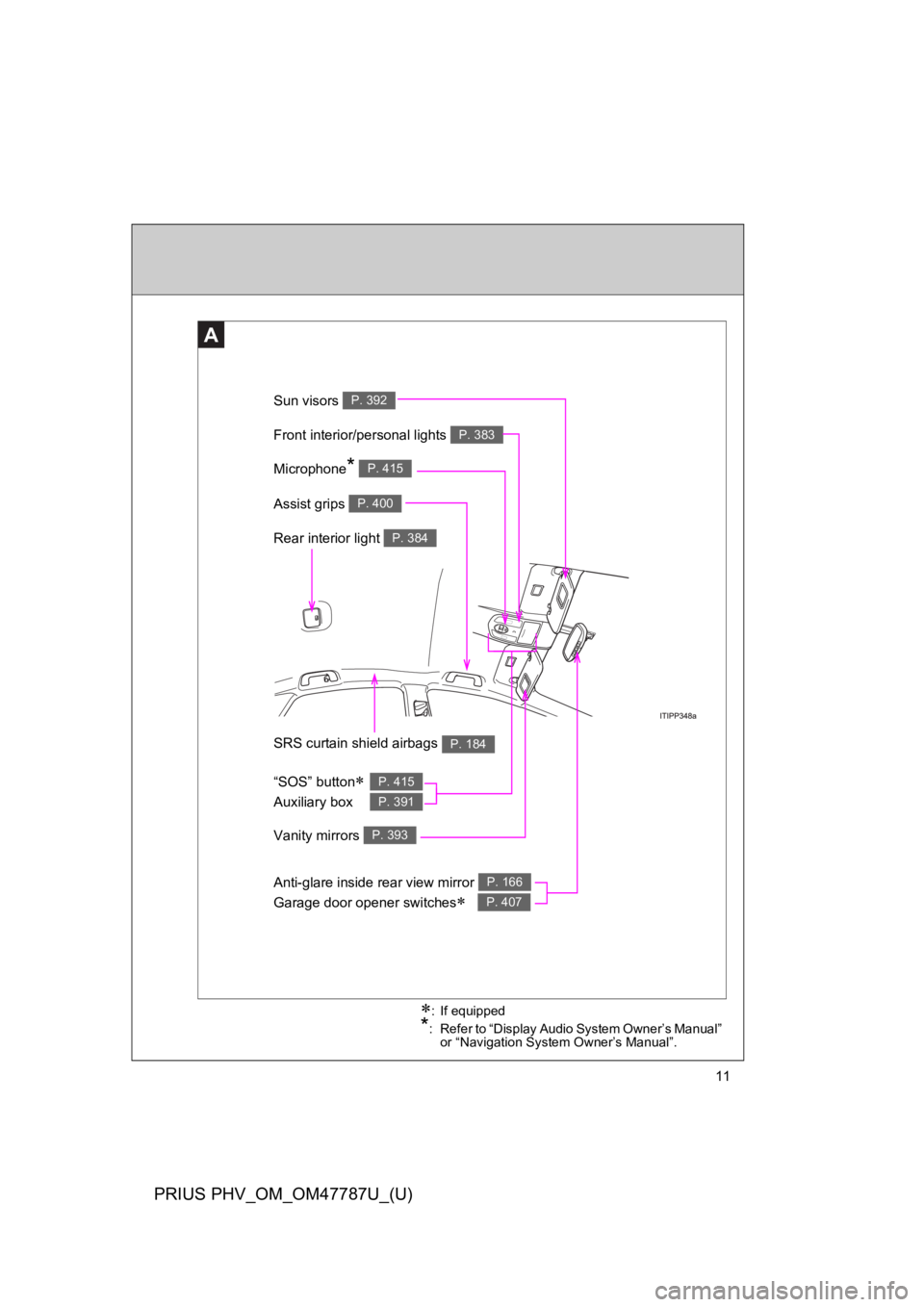
11
PRIUS PHV_OM_OM47787U_(U)
A
Anti-glare inside rear view mirror
Garage door opener switches∗
P. 166
P. 407
Sun visors P. 392
SRS curtain shield airbags P. 184
Rear interior light P. 384
Vanity mirrors P. 393
Front interior/personal lights P. 383
∗:If equipped
*:Refer to “Display Audio System Owner’s Manual” or “Navigation System Owner’s Manual”.
Microphone* P. 415
“SOS” button∗
Auxiliary box
P. 415
P. 391
Assist grips P. 400
Page 44 of 704
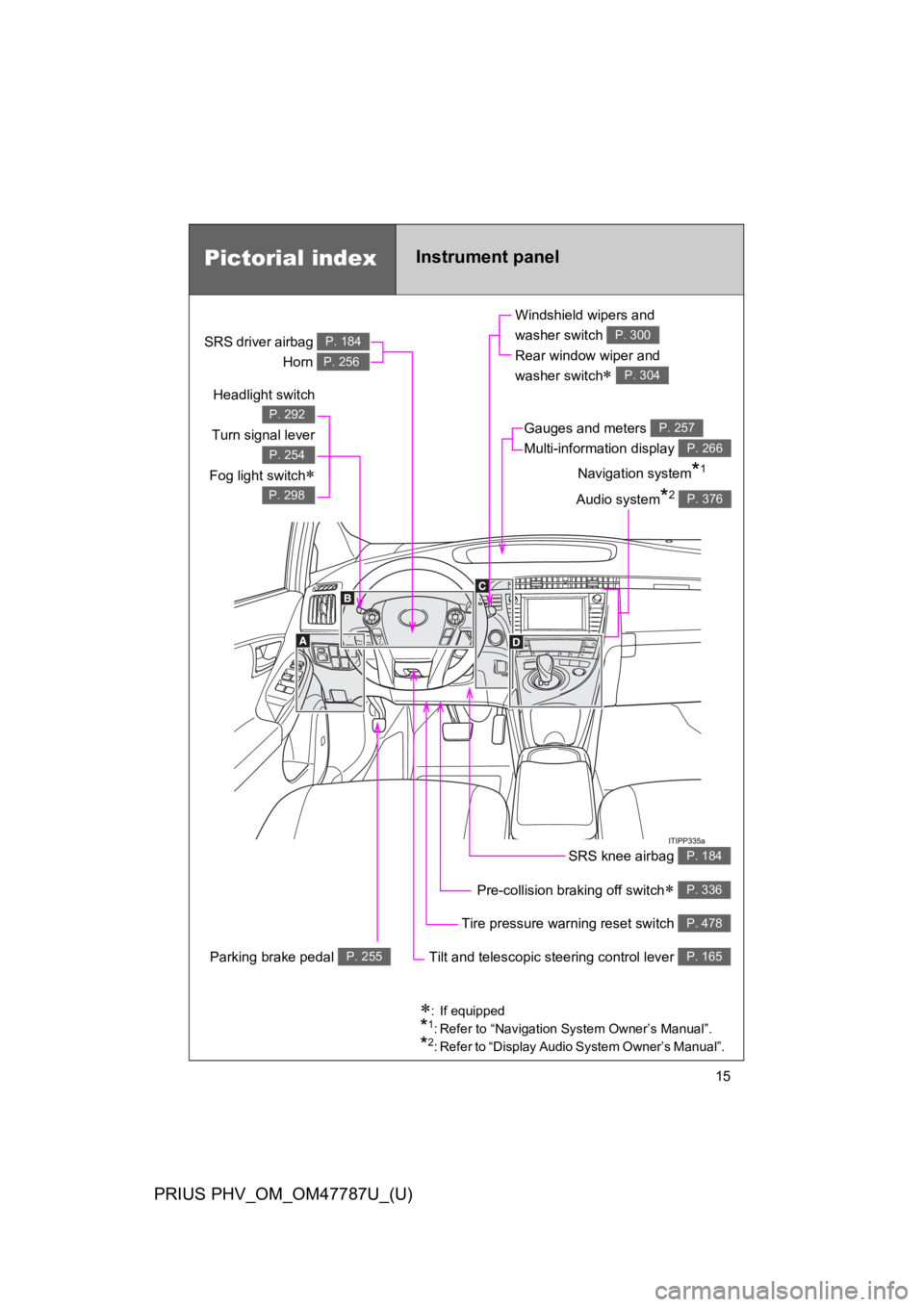
15
PRIUS PHV_OM_OM47787U_(U)
Pictorial indexInstrument panel
Headlight switch
Turn signal lever
Fog light switch∗
P. 292
P. 254
P. 298
Pre-collision braking off switch∗ P. 336
Parking brake pedal P. 255
Tire pressure warning reset switch P. 478
Windshield wipers and
washer switch
Rear window wiper and
washer switch∗
P. 300
P. 304
Gauges and meters
Multi-information display
P. 257
P. 266
Audio system*2 P. 376
Navigation system*1
SRS driver airbag
Horn
P. 184
P. 256
SRS knee airbag P. 184
Tilt and telescopic steering control lever P. 165
∗:If equipped
*1:Refer to “Navigation System Owner’s Manual”.
*2:Refer to “Display Audio System Owner’s Manual”.
Page 52 of 704

23
PRIUS PHV_OM_OM47787U_(U)
Installation of a mobile two-way radio system
The installation of a mobile two-way radio system in your vehicle could affect
electronic systems such as:
●Multiport fuel injection system/sequential multiport fuel injection system
●Cruise control system
●Anti-lock brake system
●SRS airbag system
●Seat belt pretensioner system
Be sure to check with your Toyota dealer for precautionary measures or spe-
cial instructions regarding installation.
High voltage parts and cables on the hybrid vehicles emit approximately the
same amount of electromagnetic waves as the conventional gasoline pow-
ered vehicles or home electronic appliances despite of their electromagnetic
shielding.
Unwanted noise may occur in the reception of the mobile two-way radio.
Page 55 of 704

26
PRIUS PHV_OM_OM47787U_(U)
●Disclosure of the EDR data
To y o t a w i l l n o t d i s c l o s e t h e d a t a r e c o r d e d i n a n E D R t o a t h i r d p a r t y e x c e p t
when:
•An agreement from the vehicle’s owner (or the lessee for a leased vehicle)
is obtained
•In response to an official request by the police, a court of law or a govern-
ment agency
•For use by Toyota in a lawsuit
However, if necessary, Toyota may:
•Use the data for research on vehicle safety performance
•Disclose the data to a third party for research purposes without disclosing
information about the specific vehicle or vehicle owner
Scrapping of your Toyota
The SRS airbag and seat belt pretensioner devices in your Toyota contain
explosive chemicals. If the vehicle is scrapped with the airbags and seat belt
pretensioners left as they are, this may cause an accident such as fire. Be
sure to have the systems of the SRS airbag and seat belt pretensioner
removed and disposed of by a qualified service shop or by your Toyota
dealer before you scrap your vehicle.
Perchlorate Material
Special handling may apply,
See www.dtsc.ca.gov/hazardouswaste/perchlorate.
Yo u r v e h i c l e h a s c o m p o n e n t s t h a t m a y c o n t a i n p e r c h l o r a t e . T h e s e c o m p o -
nents may include airbag, seat belt pretensioners, and wireless remote con-
trol batteries.
Page 211 of 704
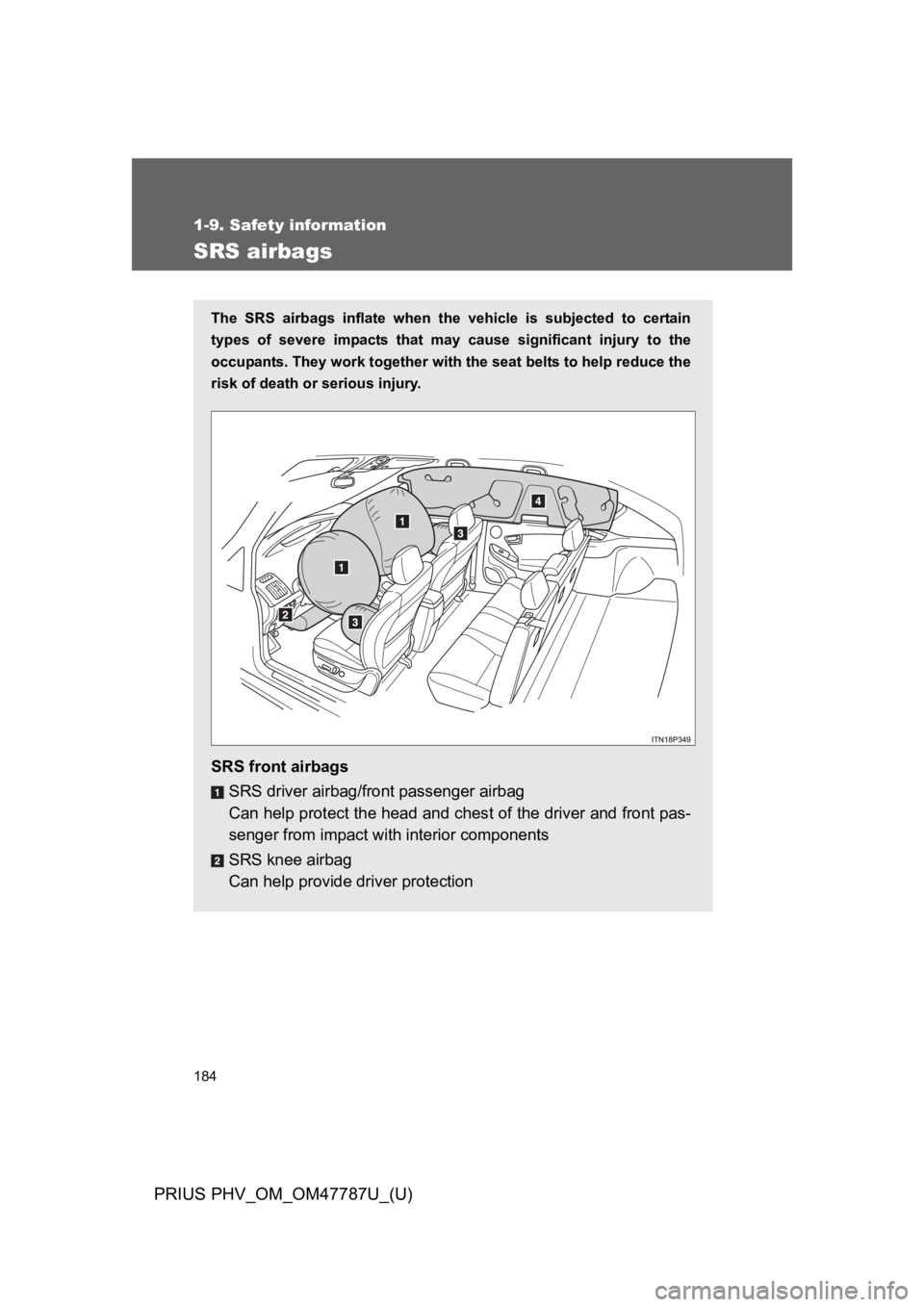
184
1-9. Safety information
PRIUS PHV_OM_OM47787U_(U)
SRS airbags
The SRS airbags inflate when the vehicle is subjected to certain
types of severe impacts that may cause significant injury to the
occupants. They work together with the seat belts to help reduce the
risk of death or serious injury.
SRS front airbags
SRS driver airbag/front passenger airbag
Can help protect the head and chest of the driver and front pas-
senger from impact with interior components
SRS knee airbag
Can help provide driver protection
Page 212 of 704
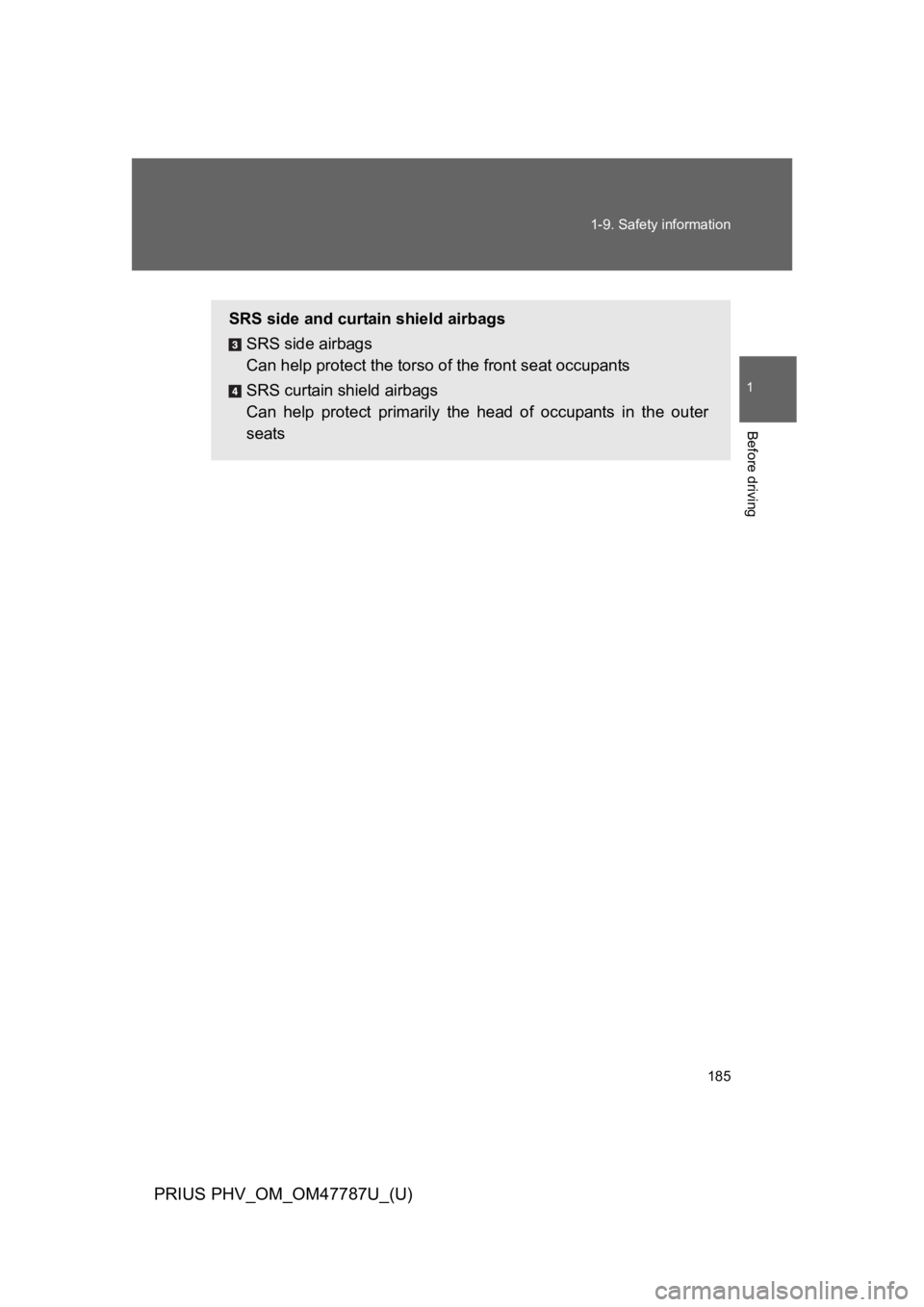
185
1-9. Safety information
1
Before driving
PRIUS PHV_OM_OM47787U_(U)
SRS side and curtain shield airbags
SRS side airbags
Can help protect the torso of the front seat occupants
SRS curtain shield airbags
Can help protect primarily the head of occupants in the outer
seats
Page 213 of 704
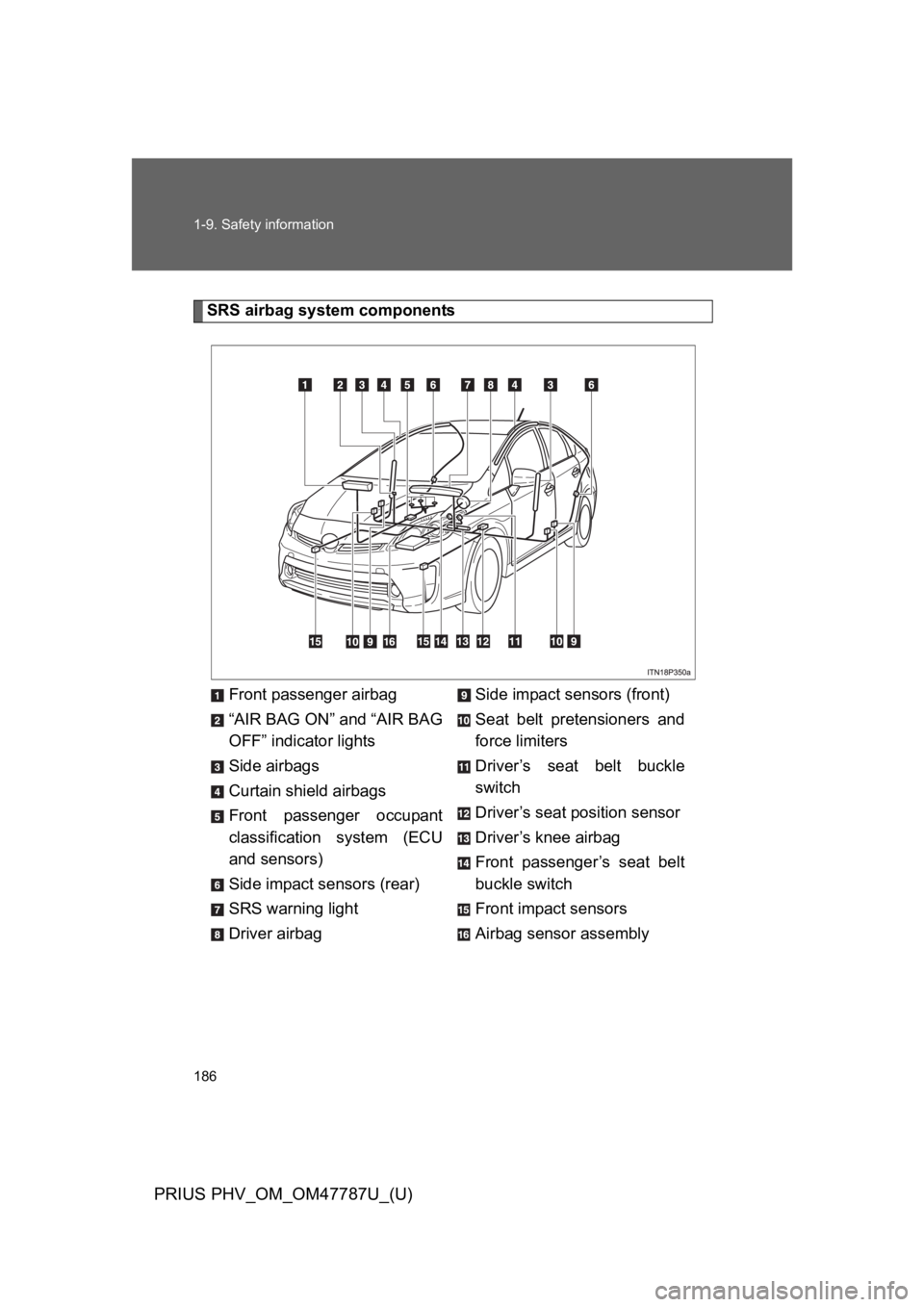
186
1-9. Safety information
PRIUS PHV_OM_OM47787U_(U)
SRS airbag system components
Front passenger airbag
“AIR BAG ON” and “AIR BAG
OFF” indicator lights
Side airbags
Curtain shield airbags
Front passenger occupant
classification system (ECU
and sensors)
Side impact sensors (rear)
SRS warning light
Driver airbag
Side impact sensors (front)
Seat belt pretensioners and
force limiters
Driver’s seat belt buckle
switch
Driver’s seat position sensor
Driver’s knee airbag
Front passenger’s seat belt
buckle switch
Front impact sensors
Airbag sensor assembly
Page 214 of 704

187
1-9. Safety information
1
Before driving
PRIUS PHV_OM_OM47787U_(U)
Yo u r v e h i c l e i s e q u i p p e d w i t h ADVANCED AIRBAGS designed based
on the US motor vehicle safety standards (FMVSS208). The airbag
sensor assembly (ECU) controls airbag deployment based on infor-
mation obtained from the sensors etc. shown in the system compo-
nents diagram above. This information includes crash severity and
occupant information. As the airbags deploy, a chemical reaction in
the inflators quickly fills the airbags with nontoxic gas to help restrain
the motion of the occupants.
■If the SRS airbags deploy (inflate)
●Bruising and slight abrasions may result from contact with a deploying
(inflating) SRS airbag.
●A loud noise and white powder will be emitted.
●Parts of the airbag module (steering wheel hub, airbag cover and inflator)
as well as the front seats, parts of the front and rear pillars, and roof side
rails, may be hot for several minutes. The airbag itself may also be hot.
●The windshield may crack.
●For Safety Connect subscribers, if the SRS airbags deploy or in the event
of a severe rear-end collision, the system is designed to send an emer-
gency call to the response center, notifying them of the vehicle’s location
(without needing to push the “SOS” button) and an agent will attempt to
speak with the occupants to ascertain the level of emergency and assis-
tance required. If the occupants are unable to communicate, the agent
automatically treats the call as an emergency and helps to dispatch the
necessary emergency services. (→P. 4 1 5 )
Page 215 of 704

188
1-9. Safety information
PRIUS PHV_OM_OM47787U_(U)
■SRS airbag deployment conditions (SRS front airbags)
●The SRS front airbags will deploy in the event of an impact that exceeds
the set threshold level (the level of force corresponding to an approxi-
mately 12 - 18 mph [20 - 30 km/h] frontal collision with a fixed wall that
does not move or deform).
However, this threshold velocity will be considerably higher in the following
situations:
•If the vehicle strikes an object, such as a parked vehicle or sign pole,
which can move or deform on impact
•If the vehicle is involved in an underride collision such as a collision in
which the front of the vehicle “underrides”, or goes under, the bed of a
truck
●Depending on the type of collision, it is possible that only the seat belt
pretensioners will activate.
●The SRS front airbags for the front passenger will not activate if there is
no passenger sitting in the front passenger seat. However, the SRS front
airbags for the front passenger may deploy if luggage is put in the seat,
even if the seat is unoccupied. (→P. 1 9 8 )
■SRS airbag deployment conditions (SRS side and curtain shield air-
bags)
The SRS side and curtain shield airbags will deploy in the event of an impact
that exceeds the set threshold level (the level of force corresponding to the
impact force produced by an approximately 3300 lb. [1500 kg] vehicle collid-
ing with the vehicle cabin from a direction perpendicular to the vehicle orien-
tation at an approximate speed of 12 - 18 mph [20 - 30 km/h]).